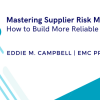Legislation regarding the environment, modern slavery and other sustainable procurement laws are coming into force at a breakneck pace. By embracing change now and adopting ethical and sustainable procurement, organizations can get ahead of the curve. Also, this socially responsible commerce movement is being thrust into the forefront of how business will operate moving forward, given the guidelines for the recent stimulus bill passed in the U.S.
As ethical sourcing has become increasingly important for consumers, senior procurement executives, who once resided in the back office, are now front and center, with new responsibilities demanded of them. Now is the time for procurement professionals to rise to the challenge and shift source-to-pay operations to be in alignment with overarching corporate social responsibility (CSR) objectives.
Brands Taking Stands: A Key Element to Win Hearts and Minds and Drive Sales and Loyalty
In a fiercely competitive market where customers have many options, socially responsible sourcing is key to winning new customers.
One study reveals the extent to which organizations’ values are becoming more important to consumers in the U.S., critical to driving both sales and consumer loyalty. Seventy-one percent of consumers identified environmentally friendly business practices as a crucial element to earn brand loyalty. Efforts to give back to the community where an organization resides and specific corporate social responsibility initiatives come next, with 68% of consumers listing these attributes as important.
However, socially responsible sourcing is rarely the most cost-effective option. Increasingly organizations understand that consumers – while wanting the companies they do business with to be socially responsible – aren’t always willing to pay a higher price.
For instance, an A.T. Kearney study of 1,000 US consumers' sentiments on environmental issues found that more than 70% consider their impact on the environment when shopping. Almost half of all respondents, across all income levels, note cost as the primary obstacle to purchasing ‘green.’
There’s a significant case to be made for socially responsible and sustainable procurement, such as saving the planet and it morally being the right thing to do. Still, for companies to wholeheartedly embrace these practices, the process must be sustainable from a business perspective. Companies that put in place sustainable procurement practices now are set to out-maneuver competitors as the business world continues to adopt this as a new de facto go-forward. As such, they’ll be positioned to command a significant share of the growing appetite for goods and services that are better for people and the planet.
Getting Started and Getting Suppliers on Board
By conducting a sustainable spend analysis, companies can evaluate and prioritize opportunities to improve environmental, social and economic performance within their supply chains.
Insights and baseline data can help organizations identify spend categories that comprise the largest environmental, social and economic benefits, and where new sourcing practices and guidelines can help organizations reach their social responsibility goals.
Many of your suppliers may already be working to improve their product lines and taking steps to implement new processes and policies that align with your objectives. And if not, it’s possible that opening dialogue and sharing goals and timelines for impact reduction may foster more collaboration and cooperation in this area.
Strategic Purchase-to-Pay Operations Supercharge Socially Responsible Sourcing
There is no turning back; socially responsible sourcing is here to stay. Organizations should look at how they can make this movement sustainable from a business perspective – or face becoming irrelevant, or worse, replaced by a more socially-conscious competitor. Being strategic with purchase to pay operations can help.
Accounts Payable (AP) visibility can help organizations master spend transparency – what is owed and when – which is critical to support creative working capital strategies that derive new revenue streams from payables. And AP automation can ensure that all invoices are captured with minimal manual intervention required, so they can be quickly matched and approved for payment.
Paying suppliers late to boost available net working capital has been part of the finance playbook for many years. Today, however, many organizations are considering that the best way to increase available net working capital instead comes from days payable outstanding (DPO) extensions. Instead, many are realizing the significant opportunity that exists within their payables to achieve risk-free returns, in lieu of, or in addition to, more traditional working capital strategies.
Organizations can gain significant savings opportunities by taking advantage of early payment discounts, volume rebates or trade spend initiatives. It’s not necessary to accept all early payment discounts. If cash on hand is deficient or the capital outlay exceeds the benefit of the discount offered, it may make sense to pay later. However, having the option to leverage early pay discounts can provide significant risk-free returns that can add substantially to the bottom line. And those dollars can help offset the higher price of sourcing in a socially responsible/environmentally friendly manner.
Winning over Internal Stakeholders
Once socially responsible sourcing practices are embedded in the organization’s procurement processes, it’s vital to measure progress. Supply chain and procure-to-pay professionals should collaborate and keep key internal stakeholders apprised on sustainable sourcing efforts.
To this end, the overall impact of socially responsible sourcing should be measured and shared in terms of the metrics that matter to them. For example, for marketing and sales, that may be revenue enablement. For others, it may be brand perceptionor social and environmental impact numbers. This is a substantial opportunity for sourcing pros to liaise with various business departments to understand what metrics are most important.
Sustaining Socially Responsible Sourcing
Getting started is crucial, finding the means to sustain socially responsible sourcing is paramount, and putting in place the mechanisms for ongoing measurement and organizational collaboration are all part of the equation. And all will need to be in place to aid supply chain and source-to-pay professionals in making the shift to support the needs of today’s value-conscious consumers.









